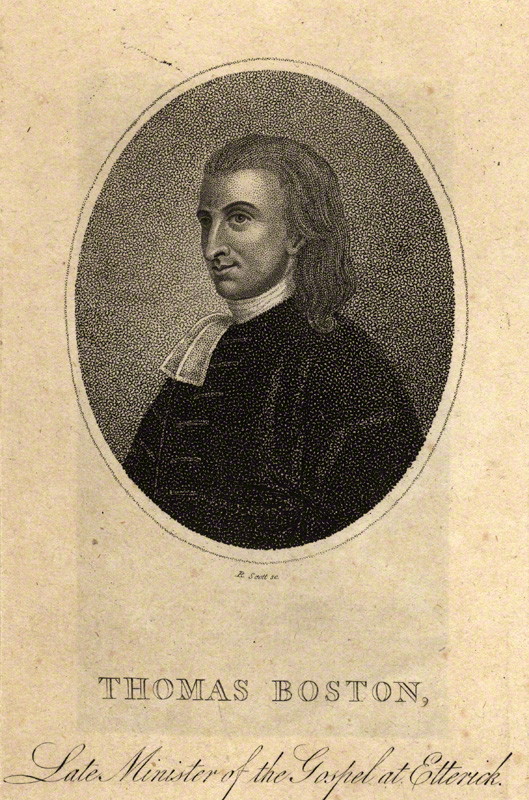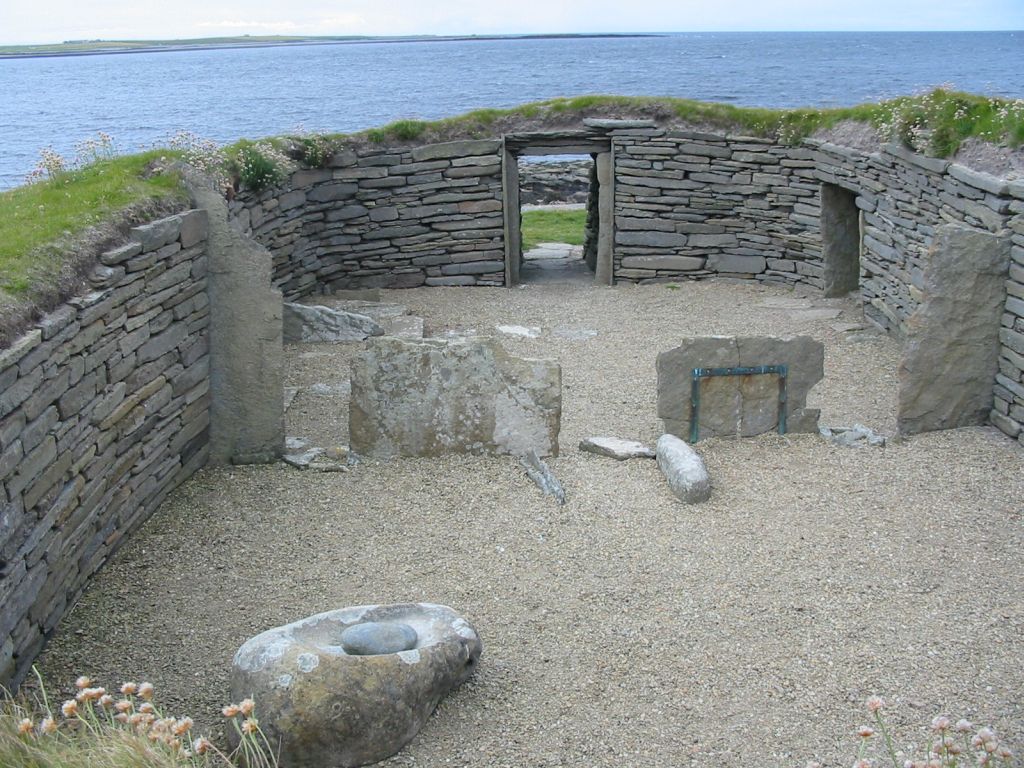|
Marrow Brethren
The Marrow Brethren or Marrowmen were a group inside Presbyterianism, the name is derived from the book " Marrow of Modern Divinity", which caused a controversy in the Scottish Church, called the Marrow Controversy. The leading figures of the Marrow Brethren included Thomas Boston, Robert Riccaltoun, James Hog, John Williamson, James Bathgate, and Ebenezer Erskine along with the author of the Marrow, Edward Fisher. The General Assembly condemned the Marrow for being allegedly "antinomian". The teaching of the Marrow Brethren is called "Marrow theology", and they have influenced many Reformed thinkers even after their condemnation in Scotland. Beliefs The Marrow of Modern divinity criticized legalism while criticizing antinomianism, the Marrow argued that antinomianism and legalism, though being opposite to each other both are opposed to grace. They had a very high emphasis on the doctrine of justification by faith alone, they highly opposed the doctrine of Neonomianism which s ... [...More Info...] [...Related Items...] OR: [Wikipedia] [Google] [Baidu] |
Republication Of The Covenant Of Works
Republication is form of Christian covenant theology where the works principle of the covenant of works was republished in some way in the Mosaic covenant. The view is popular among academics of the Westminister Seminary California and was popularized by American theologian Meredith Kline. Kline taught that the Mosaic covenant included a typological republication of the covenant of works, where the Israelites had to maintain possession of the promised land by their "typological merit". Republication is similar to the Lutheran views of the Mosaic covenant. History Some aspects of Republication were already taught by John Calvin, but not the view in its entirety. Later, Republication was taught by John Owen, believing that though the Mosaic covenant was a covenant of grace it included a layer of aspects republished from the covenant of works. Thomas Goodwin used similar language to Owen when describing the mosaic covenant. Edward Fisher, the author of the Marrow of Modern Divini ... [...More Info...] [...Related Items...] OR: [Wikipedia] [Google] [Baidu] |
History Of Christianity In Scotland
The history of Christianity in Scotland includes all aspects of the Christianity in the region that is now Scotland from its introduction up to the present day. Christianity was first introduced to what is now southern Scotland during the Roman occupation of Britain, and is often said to have been spread by missionaries from Ireland in the fifth century and is much associated with St Ninian, St Kentigern (perhaps better known as St Mungo) and St Columba, though “they first appear in places where churches had already been established”. The Christianity that developed in Ireland and Scotland differed from that led by Rome, particularly over the method of calculating Easter, and the form of tonsure until the Celtic church accepted Roman practices in the mid-seventh century. Christianity in Scotland is often said to have been strongly influenced by monasticism, with abbots being more significant than bishops, although both Kentigern and Ninian were bishops. “It is impossible ... [...More Info...] [...Related Items...] OR: [Wikipedia] [Google] [Baidu] |
18th-century Controversies
The 18th century lasted from January 1, 1701 (Roman numerals, MDCCI) to December 31, 1800 (Roman numerals, MDCCC). During the 18th century, elements of Age of Enlightenment, Enlightenment thinking culminated in the American Revolution, American, French Revolution, French, and Haitian Revolution, Haitian Revolutions. During the century, History of slavery, slave trading and human trafficking expanded across the shores of the Atlantic Ocean, Atlantic, while declining in Russian Empire, Russia, Qing dynasty, China, and Joseon, Korea. Revolutions began to challenge the legitimacy of monarchical and aristocratic power structures, including the structures and beliefs that Proslavery, supported slavery. The Industrial Revolution began during mid-century, leading to radical changes in Society, human society and the Natural environment, environment. Western historians have occasionally defined the 18th century otherwise for the purposes of their work. For example, the "short" 18th cen ... [...More Info...] [...Related Items...] OR: [Wikipedia] [Google] [Baidu] |
18th Century In Scotland
The recorded begins with the arrival of the Roman Empire in the 1st century, when the Roman province, province of Roman Britain, Britannia reached as far north as the Antonine Wall. North of this was Caledonia, inhabited by the ''Picti'', whose uprisings forced Rome's legions back to Hadrian's Wall. As Rome finally Roman withdrawal from Britain, withdrew from Britain, Gaels, Gaelic raiders called the ''Scoti'' began colonising Western Scotland and Wales. Prior to Roman times, prehistoric Scotland entered the Neolithic Era about 4000 BC, the Bronze Age about 2000 BC, and the Iron Age around 700 BC. The Gaelic kingdom of Dál Riata was founded on the west coast of Scotland in the 6th century. In the following century, History of Christianity in Ireland, Irish missionaries introduced the previously Pictish religion, pagan Picts to Celtic church, Celtic Christianity. Following Saxon England, England's Gregorian mission, the Pictish king Nechtan mac Der-Ilei, Ne ... [...More Info...] [...Related Items...] OR: [Wikipedia] [Google] [Baidu] |
1718 In Great Britain
Events from the year 1718 in Great Britain. Incumbents * Monarch – George I * Parliament – 5th Events * 7 January – Religious Worship Act 1718 repeals the Occasional Conformity Act 1711 and Schism Act 1714, restoring some freedoms to dissenters. * 15 May – James Puckle patents the Puckle Gun. * 2 August – Quadruple Alliance formed between Britain, the Kingdom of France, the Holy Roman Empire and the Dutch Republic. * 11 August – a British fleet under Admiral Byng defeats a Spanish fleet at the Battle of Cape Passaro, a prelude to the War of the Quadruple Alliance. * 24 November – 'Calico Jack' Rackham becomes captain of the pirate sloop ''Ranger'' in The Bahamas. * 17 December – War of the Quadruple Alliance: Britain, the Kingdom of France, the Holy Roman Empire and the Dutch Republic declare war on Spain. Undated * The Proper motion of stars discovered by Edmond Halley. * Marrow Controversy, an ecclesiastical dispute in Scotland, begins. * Greenwich Hospit ... [...More Info...] [...Related Items...] OR: [Wikipedia] [Google] [Baidu] |
Lordship Salvation Controversy
The lordship salvation controversy (also called lordship controversy) is a theological dispute regarding a soteriological question within Christianity on the relationship between faith and works. This debate has been notably present among some non-denominational and Evangelical churches in North America at least since the 1980s.. The dispute opposes two soteriological visions: "whether it is necessary to accept Christ as Lord in order to have Him as one's Savior. The question then becomes, If someone accepts Christ as Savior without also explicitly accepting Him as Lord, is such a person truly saved?". That is, whether accepting Jesus Christ as saviour necessarily implies one must make a concrete commitment in life toward the Christ such as following a certain behaviour or moral system. The first opinion, that of the lordship salvation supporters, is, as Arthur W. Pink summarises: "No one can receive Christ as His Savior while he rejects Him as Lord. Therefore, those who have not ... [...More Info...] [...Related Items...] OR: [Wikipedia] [Google] [Baidu] |
Westminster Seminary California
Westminster Seminary California is a Reformed tradition, Reformed and Presbyterianism, Presbyterian Christianity, Christian seminary in Escondido, California. It was initially a branch campus of Westminster Theological Seminary in Philadelphia until 1982 when it became fully independent. It currently has thirteen full-time faculty members and enrolls approximately 155 full-time students. History and ecclesiastical affiliation Westminster Seminary California was founded in 1979 and welcomed its first students in the fall of 1980. It is a multi-denominational seminary in the Presbyterian and Reformed tradition, with close relationships with several denominations, including the Presbyterian Church in America, Orthodox Presbyterian Church, United Reformed Churches in North America and Korean-American Presbyterian Church. Escondido Orthodox Presbyterian Church The Escondido Orthodox Presbyterian Church worships in the WSC Chapel. The congregation was founded in 2002 and has about 10 ... [...More Info...] [...Related Items...] OR: [Wikipedia] [Google] [Baidu] |
John Colquhoun (theologian)
John Colquhoun may refer to: * John Colquhoun (sportsman) (1805–1885), sportsman and Scots sportswriter * John Colquhoun (footballer) (born 1963), Scottish football player * John Campbell Colquhoun, British MP for Dunbartonshire, 1832–1835, Kilmarnock Burghs, 1837–1841, and Newcastle-under-Lyme, 1842–1847 * John Frederick Colquhoun, World Scout Committee member * Sir John Colquhoun, 1st Baronet (died c. 1650) *Sir John Colquhoun, 2nd Baronet (c. 1622–1676), of the Colquhoun baronets There have been two baronetcies created for persons with the surname Colquhoun ("Cohoon"), one in the Baronetage of Nova Scotia (1625) and one in the Baronetage of Great Britain (1786). The second baronetcy in 1786 was created to rectify confus ... See also * Colquhoun (surname) {{hndis, name = Colquhoun, John ... [...More Info...] [...Related Items...] OR: [Wikipedia] [Google] [Baidu] |
Netherlands
) , anthem = ( en, "William of Nassau") , image_map = , map_caption = , subdivision_type = Sovereign state , subdivision_name = Kingdom of the Netherlands , established_title = Before independence , established_date = Spanish Netherlands , established_title2 = Act of Abjuration , established_date2 = 26 July 1581 , established_title3 = Peace of Münster , established_date3 = 30 January 1648 , established_title4 = Kingdom established , established_date4 = 16 March 1815 , established_title5 = Liberation Day (Netherlands), Liberation Day , established_date5 = 5 May 1945 , established_title6 = Charter for the Kingdom of the Netherlands, Kingdom Charter , established_date6 = 15 December 1954 , established_title7 = Dissolution of the Netherlands Antilles, Caribbean reorganisation , established_date7 = 10 October 2010 , official_languages = Dutch language, Dutch , languages_type = Regional languages , languages_sub = yes , languages = , languages2_type = Reco ... [...More Info...] [...Related Items...] OR: [Wikipedia] [Google] [Baidu] |
Associate Reformed Presbyterian Church
The Associate Reformed Presbyterian Church (ARPC), as it exists today, is the historical descendant of the Synod of the South, a Synod of the Associate Reformed Church. The original Associate Reformed Church resulted from a merger of the Associate Presbytery ( from the Seceder tradition of the 18th century) and most of the Reformed Presbytery ( from the Covenanter tradition of the 17th century) in Philadelphia in 1782. The northern Synods eventually merged with the forebearers of the Presbyterian Church (USA). Because of its 1782 date of origin, it is one of the oldest of the United States' theologically and socially conservative denominations. History After the Westminster Confession was signed by its drafters in 1643, the "Covenanters," a Presbyterian group, left the Church of Scotland for the New World to avoid signing an oath to the monarch. These early believers seceded from the Church of Scotland over doctrinal differences. Some ministers stayed in the Church of Scotland to ... [...More Info...] [...Related Items...] OR: [Wikipedia] [Google] [Baidu] |
Secession Church
The First Secession was an exodus of ministers and members from the Church of Scotland in 1733. Those who took part formed the Associate Presbytery and later the United Secession Church. They were often referred to as seceders. The underlying principles of the split focused upon issues of ecclesiology and ecclesiastical polity, especially in the perceived threat lay patronage represented to the right of a congregation to choose its own minister. These issues had their roots in seventeenth century controversies between presbyterian and episcopal factions in the Church of Scotland. This was complicated by the fact that most ministers, by tradition, were the younger sons from the aristocratic families, and those same families were usually the local landowners. The local landowner therefore would often act as a "patron" to the church, not only through gifting of money, but through supply of their own relatives to fill the role of minister. There were of course some ministers from ... [...More Info...] [...Related Items...] OR: [Wikipedia] [Google] [Baidu] |




